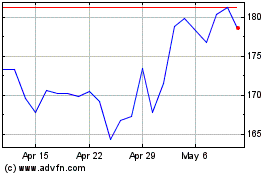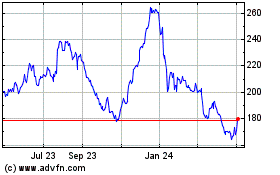Southwest Accident Puts Focus on Widely Used Engine
April 18 2018 - 8:43AM
Dow Jones News
By Robert Wall and Doug Cameron
The engine failure that killed a passenger aboard a Southwest
Airlines Co. flight puts the spotlight on one of the industry's
most commonly used engines.
CFM International -- a joint venture between General Electric
Co. and France's Safran SA -- makes engines that have become a
mainstay of commercial aviation. The engines power most of Boeing
Co. and Airbus SE's single-aisle planes, the workhorses of the
industry.
On Tuesday, one of two CFM56-7B engines ruptured on a Boeing
737-700 operated by Southwest. The engine broke apart while
Southwest Flight 1380 was at cruising altitude, flying from New
York's LaGuardia Airport to Dallas Love Field, with 149 passengers
and crew aboard. Metal pieces struck the fuselage, though the
details of what happened inside the cabin are still unclear.
Southwest two years ago suffered a similar failure on another
CFM56 engine, forcing the plane to land but not resulting in
injuries.
A probe of that incident showed evidence of fatigue cracks in
some of the blades. In response, the Federal Aviation
Administration last year proposed enhanced inspections of certain
CFM engines. It hasn't yet made the safety fix mandatory. The
National Transportation and Safety Board said it would examine
whether there were any common factors connecting the two CFM56
incidents at Southwest.
The airline, meanwhile, said late Tuesday it was stepping up
inspections of the CFM56s used in its fleet. CFM International said
it was sending a team of experts to aid the NTSB probe.
The widespread use of the engine and its unusually dramatic
failure are likely to spur more scrutiny across fleets around the
globe. European air-safety regulators said Wednesday they were
"assessing the situation" and working with U.S. counterparts.
On average, a CFM56-powered plane takes off somewhere in the
world every two seconds. The CFM56-7B version involved in Tuesday's
incident has been in service since 1997 and is used in more than
6,700 airliners.
Engine failures are rare but aren't unheard of. Robert Sumwalt,
chairman of the NTSB, said investigators see about three to four
incidents each year.
An Airbus A380 superjumbo operated by Air France in September
suffered an engine failure on a flight from Paris to Los Angeles.
The plane diverted to Goose Bay, Canada. The accident investigation
hasn't been completed.
The engine of a Boeing 767 operated by American Airlines Group
Inc. blew up in 2016 on takeoff from Chicago O'Hare International
Airport because of unexpected component wear-and-tear. Passengers
suffered injuries during the plane's evacuation.
Engines are the often-overlooked lifeblood of the aviation
industry. Engine makers spend billions of dollars to eke out
small-percentage improvements in fuel efficiency to woo airliner
buyers.
Airlines and plane makers have endured a recent run of
operational headaches because of problems with these mini power
plants. British aircraft-engine maker Rolls-Royce Holdings PLC last
week warned that some of its engines powering Boeing 787 Dreamliner
long-haul planes would require more frequent inspections because
components were wearing out faster than expected. U.S. regulators,
as a precaution, have required airlines that use those engines to
chart courses that bring planes closer to airfields to which they
could divert.
Airlines that uses those engines have had to ground planes and
cancel flights because of an earlier round of checks on them.
Rolls-Royce, no longer affiliated with the luxury-car maker, has
said it could take until at least 2021 to fix all the engines.
Pratt & Whitney, a unit of United Technologies Corp., has
struggled with the development and production of its new geared
turbofan engine. The engine maker has halted shipments to Airbus as
it works to fix the design of components, which have been wearing
out too soon. Airlines have had to idle planes in response to
actions taken by European air-safety regulators. Pratt has said it
is working to fix the problem.
CFM also is struggling with its newest engine, the Leap used on
Boeing's new 737 Max narrow-body and some Airbus A320 models. GE
Aviation President David Joyce last month said the company was
about six weeks late on engine deliveries to Boeing and Airbus.
Write to Robert Wall at robert.wall@wsj.com and Doug Cameron at
doug.cameron@wsj.com
(END) Dow Jones Newswires
April 18, 2018 08:28 ET (12:28 GMT)
Copyright (c) 2018 Dow Jones & Company, Inc.
Boeing (NYSE:BA)
Historical Stock Chart
From Mar 2024 to Apr 2024

Boeing (NYSE:BA)
Historical Stock Chart
From Apr 2023 to Apr 2024
